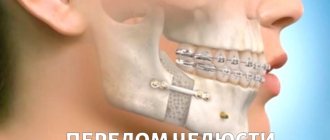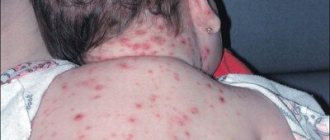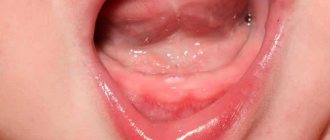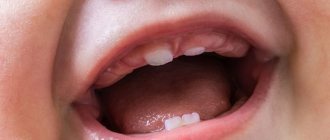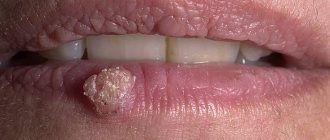What kind of coating on the tongue indicates health problems?
If there is a thickening of the plaque, a change in its color and the appearance of an unpleasant odor from the mouth , this is already the result of the activity of bacteria and fungi. Of course, the body is not a sterile substance and microorganisms are always present in it, but the immunity of a healthy child controls their numbers. When immunity decreases or any disease occurs, there is a significant increase in pathogenic bacteria and fungi, which is accompanied by the formation of plaque on the child’s tongue.
Causes of plaque on the tongue
There are many reasons why various plaques may appear on the tongue: from the banal consumption of foods that can change the color of the tongue, to serious health problems that require immediate medical attention.
Read also: Computer anesthesia STA – dentistry WITHOUT PAIN!
The very first thing you need to do when you discover strange coatings on a child’s tongue is to remember what the baby ate in the last 24 hours. Very often, sweet carbonated drinks, caramels or other sweets contain active dyes that can give the oral mucosa the most exotic shades: crimson, purple, green, orange and others. Even natural berries and fruits can radically change the color of the tongue. Therefore, there is no need to panic right away. You should ask the child to brush his teeth and tongue, and then evaluate their condition and color. If the plaque has not changed or has reappeared without connection with food intake, then this is a reason to urgently visit your pediatrician.
Main and rare types of disease
Increased bilirubin in infants is considered normal, but only in the first few days. Gradually the figures are decreasing. If this does not happen, we are talking about the development of a pathological process.
Types of jaundice in newborns (depending on the reasons for its occurrence and severity):
- physiological;
- hemolytic;
- conjugative;
- neonatal;
- nuclear;
- parenchymal;
- obstructive;
- pathological4
- mechanical.
Classification of newborn jaundice allows you to accurately diagnose and determine the direction of treatment. In uncomplicated cases, health is good. Physiological jaundice occurs in 60-70% of infants. It is also called temporary conjugation. Appears on days 3-4 (in premature infants on days 5-6) after birth without signs of anemia and hemolysis. It goes away within 7-14 days.
Conjugation jaundice develops due to the immaturity of any component of the bilirubin metabolic system. Occurs from 2 to 10 days after birth. The disease lasts from 14 to 30 days. Differential diagnosis is difficult, and symptoms may be similar to other types of jaundice. Inpatient monitoring of the young mother and baby is recommended.
Hemolytic jaundice in newborns occurs due to a history of other diseases. These may be: pulmonary infarction, liver damage, septic endocarditis, malignant tumors, malaria. Toxic effects on the body can also cause the development of this form of the disease. Diagnostics shows an increased level of stercobilin in feces and the presence of hyperbilirubinemia.
Neonatal jaundice of newborns is provoked by immaturity of liver cells, increased production of bilirubin and low ability of blood serum to bind it. If a decreasing trend in indicators is not observed, diagnostics are necessary to determine the causes. Neonatal jaundice is characterized by insufficient amounts of enzymes that are needed to neutralize excess bilirubin in the blood.
A severe form of the disease is considered to be kernicterus, which affects the brain, which is not bound by bilirubin. Symptoms develop rapidly during the first two days after birth. The baby has a mask-like facial expression, convulsions, tension in the muscles of the neck and head, and wheezing when listening. This type of jaundice in newborns has serious health consequences.
Parenchymal type is a severe form of the disease that requires immediate medical attention. It is of hepatitis origin. Obstructive jaundice is a pathological syndrome, the cause of which may be disturbances in the metabolism of metals, proteins, anatomical defects and obstruction of the bile ducts. It appears from the first days of life. Recovery is possible by the second half of the year, provided the form of the disease is uncomplicated.
The obstructive (subhepatic) form of the disease develops against the background of bile duct obstruction. There may be a history of abdominal tumors. In infants, the skin color has a greenish-yellow tint, stool is whitish, and urine is dark. Pathological jaundice in the neonatal period develops rapidly - in the first days after birth. An enlargement of the spleen and liver, and the occurrence of spontaneous bruises on the body are diagnosed. Increased hemolysis may occur if there is a history of Rh factor incompatibility between mother and baby.
White coating on the tongue
White plaque can be found in the oral cavity of a baby most often.
This phenomenon also happens normally when, after a night’s sleep, a thin white coating without an unpleasant odor is found on the tongue, disappearing after hygiene procedures and not causing any discomfort or unpleasant sensations.
The appearance of a dense whitish plaque, which is extremely difficult to remove from the surface of the tongue and does not disappear after brushing your teeth, may indicate problems with the gastrointestinal tract (gastritis, enteritis or dysbacteriosis). This phenomenon is often accompanied by bad breath. In addition, children may present complaints that may indicate gastrointestinal pathology:
- abdominal pain of various localizations;
- bloating;
- stool disorders;
- change in appetite
In order to get rid of such white plaque, it is necessary, first of all, to examine the digestive system and eliminate even the most minor disturbances in its functioning.
Read also: Drilling teeth? NO thanks, we use ICON!
In infants up to 2 months of life, thrush or oral candidiasis is a common occurrence in a nursing mother, especially after taking antibiotics or an error in diet. With this pathology, abundant cheesy white deposits appear on the tongue and cheeks, which are easily removed, and small ulcers are found underneath them. After starting treatment for thrush with antifungal agents and treating the oral cavity with antiseptic solutions, the tongue and other mucous membranes quickly cleanse and regain their previous appearance.
What to do with all this
The most important thing that doctors (including Dr. Komarovsky) advise in such a situation is not to panic and try to treat the child with traditional methods or advice from the Internet. In any case, you should visit your pediatrician for an examination and possible further examination. This is especially true if the child complains of weakness and high temperature.
- The effect of food coloring . It is necessary to temporarily remove all coloring foods from the baby’s diet and everything will go away on its own and without a trace. To speed up this process, you can thoroughly clean the surface of the tongue with a soft toothbrush and continue to monitor the quality of your child’s oral hygiene.
- Plaque of fungal origin . You should not try to remove it. Treatment in such cases will consist of taking antifungal drugs in combination with treating the oral cavity with antiseptic solutions.
- Pathology of the digestive system . Elimination of the root cause leads to the rapid disappearance of any manifestations of black tongue. In the treatment of dysbiosis, eubiotic preparations (Linnex, Lacidofil, Bifidumbacterin and others) are good helpers, as well as following a gentle but rational diet.
- Hypovitaminosis . They are well corrected with complex vitamin preparations, with treatment with which all symptoms go away very quickly.
- Black hairy tongue . In this case, there is no specific therapy. This phenomenon most often goes away on its own. It is necessary to apply only preventive measures and treat the child’s oral cavity with antiseptic solutions.
Despite the fact that most often the causes of a black tongue in a child do not threaten his health, a visit to the pediatrician’s office should not be ignored. Only a specialist will help determine why such a problem appeared and how quickly it can be solved.
Gray coating on the tongue
A gray coating on the tongue can be a sign of some infectious diseases.
For example, with scarlet fever, on the very first day the mucous membranes become covered with a dirty gray coating, which, starting from the tip of the tongue, gradually disappears and reveals a “raspberry tongue” - enlarged papillae on a bright red background, which is very reminiscent of raspberries.
With diphtheria, gray filmy deposits can be found on the root of the tongue, which are difficult to separate. Such plaques spread to the mucous membranes of the throat, palatine arches and are accompanied by coughing and attacks of suffocation.
Treatment of such infectious diseases is carried out only in a hospital setting. After healing, all plaque on the tongue disappears.
Dehydration in a child can also lead to the formation of a gray coating on the surface of the tongue. At the same time, the mucous membranes look dry and dull. Replenishing the required volume of fluid quickly eliminates this symptom.
Yellow coating on the tongue
A dense yellow coating on the tongue indicates pathology of the liver or biliary tract.
Often in children, diseases of the biliary system occur without a clear clinical picture, and the presence of bile stagnation can only be suspected by a change in the color of deposits on the mucous membranes of the oral cavity.
If a child has a yellow coating on the tongue , it is necessary to urgently consult a doctor and have an examination of the internal organs and the biochemical composition of the blood.
Read also: Medication sleep - WHAT? For what? HOW?
Green coating on the tongue
The appearance of a green coating on the mucous membrane of the tongue often frightens parents, especially if it is found in a newborn or infant.
The most common cause of this phenomenon is candidiasis - a fungal infection of the oral cavity that occurs due to imperfect immune defense in the body of a 1-year-old baby or while taking strong antibacterial drugs.
This plaque has varying color intensities and can spread to other parts of the oral cavity, found on the cheeks, palate and lips. After removing it, you can see the red surface of the tongue with small blisters or ulcers, which cause discomfort to the child.
You should start treating green plaque only after consulting a doctor. Therapeutic measures will consist of taking special drugs with antifungal action and local antiseptics to treat thrush and prevent bacterial complications.
Read also: How bite affects posture and spinal health
Symptoms
Desquamative glossitis or geographic tongue is a common condition. The frequency of its development is up to 42% (depending on the general condition and concomitant diseases). For example, in patients with exudative diathesis, the probability of developing glossitis is 65%. The main symptoms of the disease are:
- At the first stage, whitish-gray areas, usually small, appear on the surface of the epithelium. Over time they begin to swell. Gradually peeling off, they form spots, often round, from bright pink to red.
- As the disease progresses, the desquamation zone grows rapidly. The spots can be single, in some cases they form multiple formations. The main localization area is the back and lateral surfaces of the tongue. The affected area extends to the lower part.
Desquamation rarely causes discomfort, only in some cases accompanied by a burning sensation and tingling sensation. The disease does not cause serious physical distress, but can be a psychological irritant due to changes in the appearance of the tongue. Sometimes it disappears spontaneously, appearing again after some time.
Brown coating on the tongue
A brown tongue in a child is not such a rare occurrence. There can be many reasons for this:
- Severe diseases of the digestive system , accompanied by inflammatory changes, stagnation of bile in the bile ducts, and disruption of the digestive processes.
- Constant dehydration of the child's body due to high ambient temperatures or insufficient fluid intake.
- Insufficient intake of B
- Taking certain medications : antibiotics, antiseptic solutions, concentrated herbal decoctions.
It is very difficult to establish the exact root cause of the appearance of such a dark plaque. This can only be done by an experienced doctor, who, after additional examinations, will be able to prescribe the optimal treatment.
Why might it appear?
Keep in mind! Most often, a child’s taste organ darkens for the following reasons:
- Eating large amounts of food containing natural or synthetic dyes . Candies, tea, lemonade, dark berries (currants, blackberries, blueberries, mulberries), as well as jams and compotes based on them, can color your tongue dark.
- Taking certain medications. This organ is often colored dark by iron preparations in the form of drops, which are prescribed to the baby to treat anemia. Also, the color of the taste organ often changes during prolonged treatment with antibiotics, or when taking activated carbon.
In rare cases, the tongue darkens for reasons unknown to modern medicine.
Thus, the surface of the taste organ may darken due to excessive growth of the papillae of the tongue, followed by their keratinization and darkening .
Stay up to date! This phenomenon is called “villous tongue”; in the absence of complaints, special treatment is not required, and the condition of the taste organ is normalized within a few weeks.
Less commonly, the cause of darkening of a child’s tongue is various pathological conditions of organs and body systems:
- gastritis;
- colitis;
- enteritis;
- pathologies of the gallbladder and pancreas;
- acute deficiency of B vitamins and vitamin PP;
- dysbacteriosis;
- stomatitis;
- caries;
- oral candidiasis;
- Crohn's disease;
- lead poisoning;
- immunodeficiency, HIV;
- severe dehydration;
- infectious diseases of the upper and lower respiratory tract: sore throat, ARVI, bronchitis.
Note! The cause of dark plaque in a baby can also be acidosis - a shift in the acid-base balance of the body towards increasing acidity.
Black coating on the tongue
The presence of a black coating on a child’s tongue looks quite scary, and there may be several reasons for this phenomenon:
Bacterial sore throat is often accompanied by the appearance of dark plaques on the mucous membranes, even black. In this case, the child will have signs of inflammation in the tonsils: red throat, high fever, pain when swallowing, weakness.
Hidden forms of diabetes mellitus, which lead to persistent disruption of the acid-base balance in the body. Excess acid or acidosis will cause darkening of the tongue.
Taking some antibiotics causes the growth of pathogenic microflora in the mouth, which causes the mucous membranes to become permanently stained black.
Treatment of such plaque will consist of eliminating the causes that caused its appearance. After a sore throat is treated, medications are stopped, or diabetes is identified and compensated for, this symptom will most likely go away on its own.
Associated symptoms
If a black coating is detected on the child’s organ of taste, you should pay special attention to the child’s accompanying symptoms and complaints.
Possible symptoms:
- nausea and vomiting;
- diarrhea with particles of undigested food;
- loss or abnormal increase in appetite;
- stomach ache;
- dry or bitter mouth;
- weakness;
- temperature increase;
- headache;
- redness of the mucous membranes of the mouth and tonsils;
- pain when swallowing.
It is worth noting! Sometimes, even in the presence of dark gray and black deposits on the tongue, the child voices absolutely no complaints.
The complete absence of accompanying symptoms is characteristic of fungal infection of the mucous membranes of the mouth, as well as when plaque occurs for non-pathological reasons.
Blue coating on the tongue
A blue tongue is a sign of blood stagnation.
Very often, various diseases of the cardiovascular (congenital heart defects, arrhythmias, heart failure) and nervous system (hemorrhages, cysts, epilepsy) lead to the fact that blood flows through the tissues more slowly than it should - cyanosis or cyanosis appears on the limbs, lips and language. Therefore, if you notice such a symptom in your child, you should urgently contact your doctor for advice.
Read also: Now the beauty and health of your child is completely in your hands
Prevention
In order to prevent the appearance of plaque on a child’s tongue, there are a number of preventive measures that many experts focus on:
- The room in which the child lives should always be clean, well ventilated and humidified.
- You should not prescribe antibiotics to your child yourself. The use of such medications must be strictly justified.
- It is necessary to closely monitor the baby's health. If the slightest symptoms appear that indicate a possible disease from the internal organs, you should urgently seek medical help.
- Limit your child's consumption of sweets containing synthetic coloring pigments: sweet carbonated drinks, candies, chewing gum. This will not only prevent the appearance of active staining of the tongue, but will also preserve the health of delicate children's teeth.
If plaque does appear on the tongue, there is no need to try to remove or treat it yourself. Consult your doctor about the possible causes of this phenomenon and the necessary treatment for it.
Posted in For parents by biglamed


